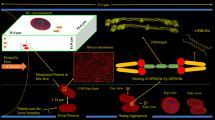Abstract
We have previously described the development of a two-dimensional computational model of platelet deposition onto biomaterials from flowing blood (Sorensen et al., Ann. Biomed. Eng. 27:436–448, 1999). The model requires estimation of four parameters to fit it to experimental data: shear-dependent platelet diffusivity and three platelet-deposition-related reaction rate constants. These parameters are estimated for platelet deposition onto a collagen substrate for simple parallel-plate flow of whole blood in both the presence and absence of thrombin. One set of experimental results is used as a benchmark for model-fitting purposes. The “trained” model is then validated by applying it to additional test cases from the literature for parallel-plate Poiseuille flow over collagen at both higher and lower wall shear rates, and in the presence of various anticoagulants. The predicted values agree very well with the experimental results for the training cases, and good reproduction of deposition trends and magnitudes is obtained for the heparin, but not the citrate, validation cases. The model is formulated to be easily extended to synthetic biomaterials, as well as to more complex flows. © 1999 Biomedical Engineering Society.
PAC99: 8719Uv, 8710+e, 8717Aa, 8768+z, 4760+i
Similar content being viewed by others
REFERENCES
Alevriadou, B. R., J. L. Moake, N. A. Turner, Z. M. Ruggeri, B. J. Folie, M. D. Phillips, A. B. Schreiber, M. E. Hrinda, and L. V. McIntire. Real-time analysis of shear-dependent thrombus formation and its blockade by inhibitors of von Willebrand factor binding to platelets. Blood 81:1263–1276, 1993.
Batchelor, G. K. An Introduction to Fluid Dynamics. Cambridge: Cambridge University Press, 1967.
Eckstein, E. C., and F. Belgacem. Model of platelet transport in flowing blood with drift and diffusion terms. Biophys. J. 60:53–69, 1991.
Fogelson, A. L. Continuum models of platelet aggregation: formulation and mechanical properties. SIAM (Soc. Ind. Appl. Math.) J. Appl. Math. 52:1089–1110, 1992.
Folie, B. J., and L. V. McIntire. Mathematical analysis of mural thrombogenesis. Concentration profiles of plateletactivating agents and effects of viscous shear flow. Biophys. J. 56:1121–1141, 1989.
Hubbell, J. A., and L. V. McIntire. Visualization and analysis of mural thrombogenesis on collagen, polyurethane and nylon. Biomaterials 7:354–363, 1986.
Keller, K. H. Effect of fluid shear on mass transport in flowing blood. Fed. Proc. 30:1591–1599, 1971.
Munter, W. A., and P. D. Stein. Newtonian behavior of blood at high rates of shear. Biorheology 10:501–508, 1973.
Rosing, J., J. L. M. L. van Rijn, E. M. Bevers, G. van Dieijen, P. Comfurius, and R. F. A. Zwaal. The role of activated human platelets in prothrombin and factor X activation. Blood 65:319–332, 1985.
Sakariassen, K. S., and H. R. Baumgartner. Axial dependence of platelet-collagen interactions in flowing blood. Upstream thrombus growth impairs downstream platelet adhesion. Arteriosclerosis (Dallas) 9:33–42, 1989.
Sorensen, E. N., G. W. Burgreen, W. R. Wagner, and J. F. Antaki. Computational simulation of platelet deposition and activation: I. Model development and properties. Ann. Biomed. Eng. 27:436–448, 1999.
Turner, N. A., J. L. Moake, S. G. Kamat, A. I. Schafer, N. S. Kleiman, R. Jordan, and L. V. McIntire. Comparative realtime effects on platelet adhesion and aggregation under flowing conditions of in vivo aspirin, heparin, and monoclonal antibody fragment against glycoprotein IIb/IIIa. Circulation 91:1354–1362, 1995.
Wagner, W. R., and J. A. Hubbell. Local thrombin synthesis and fibrin formation in an in vitro thrombosis model result in platelet recruitment and thrombus stabilization on collagen in heparinized blood. J. Lab. Clin. Med. 116:636–650, 1989.
Wagner, W. R., and J. A. Hubbell. Evidence for a role in thrombus stabilization for thromboxane A2 in human platelet deposition on collagen. J. Lab. Clin. Med. 119:690–697, 1992.
Yeh, C., A. C. Calvez, and E. C. Eckstein. An estimated shape function for drift in a platelet-transport model. Biophys. J. 67:1252–1259, 1994.
Author information
Authors and Affiliations
Rights and permissions
About this article
Cite this article
Sorensen, E.N., Burgreen, G.W., Wagner, W.R. et al. Computational Simulation of Platelet Deposition and Activation: II. Results for Poiseuille Flow over Collagen. Annals of Biomedical Engineering 27, 449–458 (1999). https://doi.org/10.1114/1.201
Issue Date:
DOI: https://doi.org/10.1114/1.201




